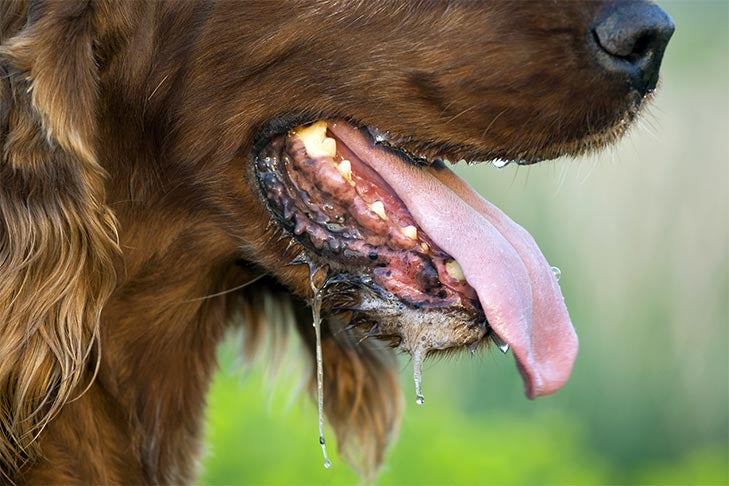AKC is a participant in affiliate advertising programs designed to provide a means for sites to earn advertising fees by advertising and linking to akc.org. If you purchase a product through this article, we may receive a portion of the sale.
Before leaving for work on a summer morning, Meredith turned on the air conditioner to keep her two beloved pets comfortable. Unfortunately, hours later, the power failed. Jazz and Ginger, gated in a sunny room, panted anxiously as they began to overheat. The house warmed quickly, and there was nowhere to find relief. Here’s why dogs overheating is dangerous and how to recognize signs (and prevent) overheating in dogs.
Why Dogs Overheat
Exercise, excitement, or infection can cause a dog’s temperature to rise normally. But when a dog’s body temperature rises only a few degrees over 102 degrees Fahrenheit, a dog becomes overheated, and it’s important to take action before heat exhaustion occurs.
When humans sweat, heat is transferred from the moisture over our entire body to drier, cooler air around it. Evaporation of this sweat cools us, and a fan makes it happen faster. However, as former French Bulldog Club of America president Jan Grebe, Ph.D., notes, “Dogs don’t sweat.” At least, not how we experience sweating.


Dogs pant because they have few sweat glands. Dogs inhale cooler, drier air through the nose and upper airways, exchanging that in the lungs for warm, moist air as evaporative cooling takes place (the dog’s equivalent of our sweating mechanism). The breathing rate increases from 40 to 400 breaths per minute, with an occasional deep breath. After the dog sucks cooler air into the lungs, they exhale hot, moist air through the mouth over the dripping tongue, expelling excess body heat.
Panting animals, then, need enough cool water to drink on warm days to keep those airways moist, maintaining a delicate temperature balance. But if the outside environment is also very moist, less evaporation and cooling occur. This may result in a reduced tolerance for hot, humid weather and a greater danger of the dog overheating.
Signs of Overheated Dogs
As a dog’s temperature rises, blood rushes to the surfaces of the tongue, gums, and membranes to help transfer excess heat. Clear warning signs of overheating in dogs include frantic panting, extreme salivation, bright-red membranes, and labored breathing. The condition may quickly progress to a metabolic meltdown as their temperature rises to over 106 degrees Fahrenheit and dogs can no longer cool themselves.
An overheated dog may gasp for air, and the entire mouth will become grayish to purple because of the unmet oxygen demand. As the dog becomes dehydrated, their saliva thickens, and the dog may vomit and have diarrhea. Unable to stand, the dog might even have a seizure, become comatose, and die. Even if you can cool down the dog and they’re acting normally, rush them to an emergency clinic because their organs may have already been damaged and death could follow.
Why Some Dogs Overheat More Easily
Keep a close eye on double-coated dogs when summer temperatures rise, when traveling, or when there’s an unusual heat wave in your area. Although a dog’s coat can provide insulation from both heat and cold, double coats can make a dog more vulnerable to overheating. Black and other dark-colored coats also absorb heat faster in the sun.
Brachycephalic dogs — dogs with shorter muzzles and flatter faces — tend to be more heat-sensitive. Their airways may be less efficient at moving air in and out of the lungs, making the dog more vulnerable to overheating.
All dogs are vulnerable to heatstroke, and every owner needs to be acutely aware of their dogs’ limits. Some brachycephalic dogs, like Pugs and Bulldogs, may be more sensitive to high heat and humidity, so owners should pay close attention to their breathing. Also, even dogs accustomed to exercise may overheat easily when exercising on hot days.
Grebe warns, “Anything that causes brachycephalic dogs to breathe harder places additional stress on their airways, whether it is overheating on a hot day, excitement that causes panting, or exercise that increases the oxygen demand of their muscles, requiring more strenuous breathing.”
Chronic respiratory challenges also tend to cause irritation with more salivation and swelling in the throat. This further restricts air movement as passages narrow. Eventually, the respiratory system loses elasticity with repeated challenges, and with an increased effort to breathe, the walls of the airway may be drawn inward. Grebe explains, “Try pinching your nose shut, close your mouth, and inhale. Feel the walls of your larynx and trachea being sucked in.”
Over time, the increased effort to breathe causes a progressive inward collapse of the walls of the larynx, which may be fatal. “Careful breeding of brachycephalic dogs should make good airways a priority in breeding stock,” Grebe says. Carrie Forsyth, who breeds and shows Pekingese, avoids the problem of overheating by selecting against pinched nostrils and other upper-respiratory abnormalities in her breeding program.
How to Keep Your Dog From Overheating
Forsyth brings cool packs for dogs, dog towels, ice, and spray bottles with her Pekingese in any weather. “You never know when it can become too warm,” she warns. She suggests show superintendents hold classes for brachycephalic dogs in the morning and advises people to bring helpers when showing multiple dogs to watch over them.

If you think your dog is overheating, Grebe advises that you quickly move them to a cool place and immediately spray cool (not cold or icy) water on the coat, ensuring it reaches the skin. Cold water tends to constrict the surface blood vessels in the skin and this reduces, instead of increases, heat loss. Here are other ways to help prevent overheating in dogs:
- Ensure that your dog always has plenty of fresh water and shade, putting them outside only for short periods in hot weather.
- Use a variety of dog cooling products, such as dog cooling vests and wraps. dog cooling mats, and cooling beds for dogs.
- Don’t leave your dog in the car in any weather, whether or not the windows are cracked. Even on a cool day (the mid-60s), the temperature in a closed car rises to 130 degrees Fahrenheit in minutes. The dog’s own body temperature increases the heat and moisture (especially for larger breeds), using up oxygen, and death can occur within 15 minutes.
- Get your dog used to hot weather gradually. Don’t exercise them on hot, humid days. Even sporting dogs, such as water retrievers, can overheat if the water is warm.
- Make sure to keep your home cool on warm days. Install a temperature alarm in your motor home, van, and house that contacts your cell phone automatically. If air conditioners and electricity fail and owners aren’t aware, dogs may be in danger.
- Don’t place crated dogs under tents or in places that have poor or inadequate ventilation or warm, stagnant air.
- Carefully observe elderly dogs, those that are chronically ill, or pets that have trouble breathing.
- Be careful whenever you’re using dog dryers, especially cage dryers.
- Contact your veterinarian and your breed club and ask about heat sensitivity in your breed.
- Use an electric fan to draw heat from the blood at the body surface. You can also fan an overheated dog yourself if an electric fan is unavailable.
Observe your dog carefully, and if you notice symptoms of overheating, don’t wait until it’s too late. Take precautions to prevent overheating, and know when it’s time to take immediate action.
This article is intended solely as general guidance, and does not constitute health or other professional advice. Individual situations and applicable laws vary by jurisdiction, and you are encouraged to obtain appropriate advice from qualified professionals in the applicable jurisdictions. We make no representations or warranties concerning any course of action taken by any person following or otherwise using the information offered or provided in this article, including any such information associated with and provided in connection with third-party products, and we will not be liable for any direct, indirect, consequential, special, exemplary or other damages that may result, including but not limited to economic loss, injury, illness or death.


